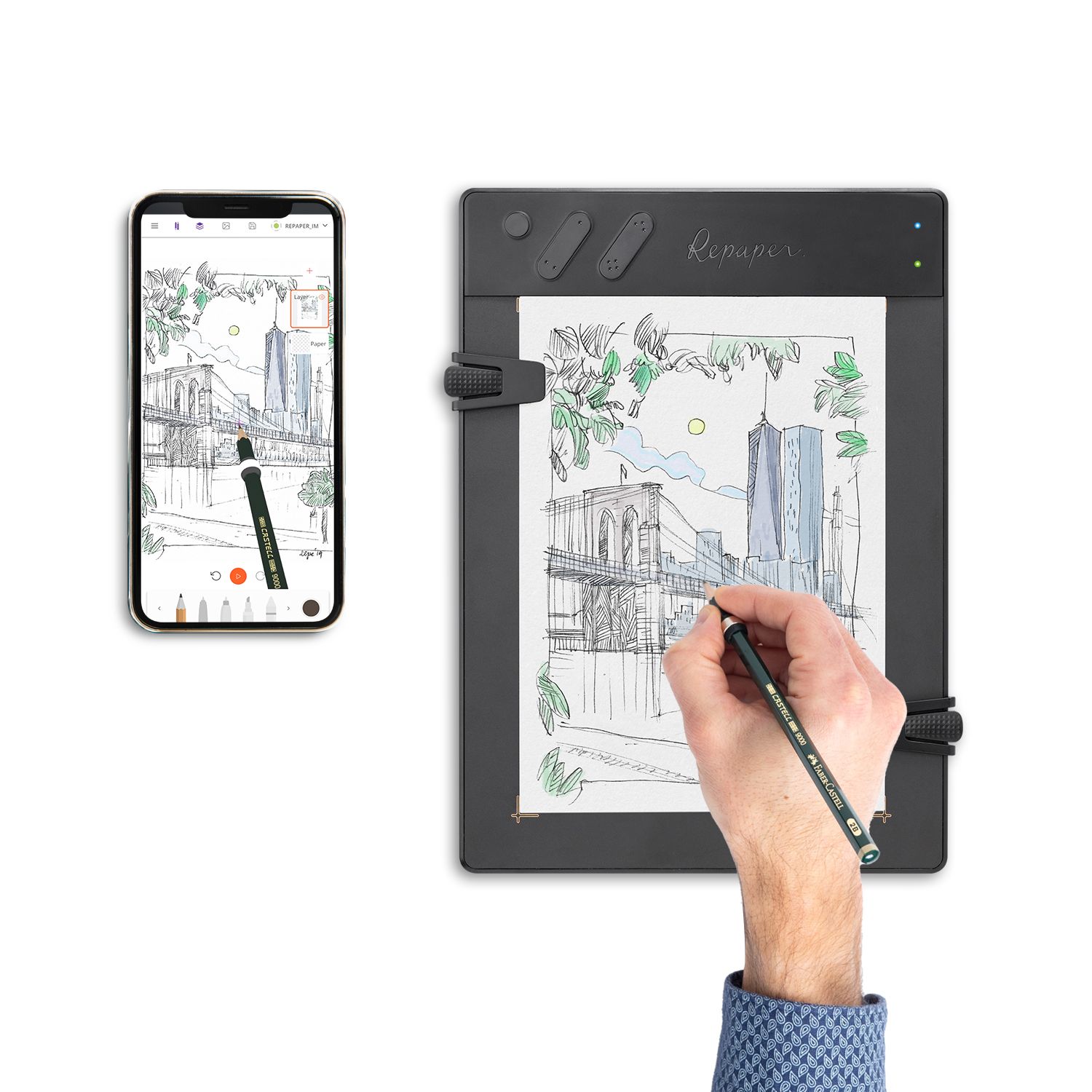
Key elements for remote teaching.
With the current situation having changed the way classes are taught and with the explosion of distance learning, teachers must now adapt their pedagogical tools and change their way of conceiving a class, in order to succeed in offering an effective distance learning experience, which will capture the attention of their students. Whether it is for higher education or for high school students, distance learning modules are now legion, and the educational team has several options available. Virtual classrooms, teaching platforms, etc... No need to attend a classroom to teach students what they need to succeed in their studies. Thus, the teacher must use effective digital tools, and it is within this framework that effective software and peripherals such as a graphics tablet can become real assets for holding virtual classes. We will see below how this new standard requires to adapt to its audience, how to realize interactive virtual courses, both for the trainers and for the students, and also how digital pedagogical innovations become an essential factor to realize this new training offer.
Innovative equipment for distance learning.
To achieve a quality pedagogical approach, from elementary school to tertiary education, including open and distance learning courses, adding innovative technology tools to a learning platform can be a real solution to enable learners to be more proactive during distance learning classes. These tools provide flexibility for a wide range of interactive educational activities and the creation of training modules that are directly related to the students. To teach in college or in classes requiring to catch the attention and the curiosity of the students, going beyond the devices provided by the school board, allows to involve the students by making them actively participate in the course. This makes many teaching resources usable and editable in real time, and makes online classroom teaching much more engaging for school children and students.
Among the tools that are affordable and usable by the greatest number of people, we find first of all the video conferencing software and the graphic tablet. Video conferencing software is an essential educational tool to keep the link between the teacher and the student. Many companies offer their software today, and among the most famous are Zoom, Meet, or Teams, with many options to facilitate classes in a dynamic way to capture audiences.


As for the drawing tablet, it will be a real plus to the organization of certain distance learning courses. While it may seem that many subjects and disciplines cannot be taught remotely, especially those requiring live writing or drawing (such as engineering, or even learning to write letters for the little ones), the drawing pad can introduce a new pedagogy, and offers live writing and drawing, just as one would do on a blackboard in a classroom. Teaching new skills to students becomes easier, and the compatibility of some drawing tablet, such as the ISKN Repaper, with whiteboards and online video conferencing software, makes it much easier to set up distance learning.
For teachers and trainers, the fact remains that using these tools imposes a learning process that can sometimes be time-consuming, especially in the urgency imposed by the widespread use of videoconferencing classes. Choosing the right tablet is important to be able to communicate the concepts of the course in an easy and natural way for the students. This is where the "scanner" drawing tablet comes into play. Contrary to a drawing tablet without a screen, which will require a particular hand-eye coordination, the latter requiring to write on the black touch surface with a stylus, while looking at the screen to see the result displayed live, the scanner tablet, like the ISKN Repaper, allows the user to affix a sheet of paper directly on the touch surface, and thus teach and illustrate words with a simple paper and pencil. The result of each stroke is then instantly transcribed in the graphics software or in the whiteboard of the videoconferencing software, thanks to the technology of this type of tablet, which brings fluidity to your lesson, and attracts the attention of the participants. This makes it easier for the teacher to focus on the concepts to be taught to the students, and to distill the lesson naturally, without having to concentrate on the strokes he or she is trying to draw. Everyone can use this tool easily and instantly, without being trained beforehand.

Distance learning, a new norm requiring adaptation.
The widespread use of courses conducted remotely from the teaching site, via computer tools, arrived very quickly, and teachers soon found themselves having to train themselves, but also to train learners, to use this type of distance learning device. Designing a lesson, sometimes in the context of a hybrid set-up combining a face-to-face and a virtual classroom, via video-conferencing, can become a real challenge for teachers and tutors.
The learning environment: a real change from one place to another.
The support of the learners and the training of the teachers will be very different depending on the learning structure in which the teaching is located. For an independent training organization or for professional training, the resources put in place are generally the same as for the general public or companies. It is then simple to be trained to use them, but it will require an independent organization from the class leader, so that each student can have access to the links leading to the pedagogical contents, to the schedule of each one or to the virtual classes. For schools, the Ministry of Education provides real support to teachers via a pedagogical platform, and access to digital resources is facilitated by a portal where each student will find lessons, exercises, and links to online classes. It is then easier to organize, but these digital learning tools may require training for teachers who are not necessarily comfortable with them. Moreover, contrary to the general public tools, which are really adapted to the computer peripherals that can be used to give more dynamism to the courses, it can be more complicated to synchronize them on the software provided by the national education.

Adapt to your audience.
The audience you are addressing has a real impact on the way you run a course entirely at a distance from the teaching site. While for people in vocational training, or those who have chosen open distance learning, student motivation is not a concern. Digital teaching for high school students as well as for college students requires the design of educational modules and the availability of numerous educational resources. These ensure attendance by allowing learners to follow these courses via the Internet. In all instances, tutoring several dozen students at a distance requires interactivity, which implies designing a clever device to make the class come alive. It is thus possible to interact with the students, thanks to adapted equipment, such as a whiteboard software and a pen tablet in order to meet the learners' expectations and to ensure their presence in each class. This maximizes the primary goal: the validation of the required competencies. Moreover, in the context of a hybrid course, using digital tools that reproduce the experience of being in the classroom ensures that a student who is not normally involved will not turn distance into absence.

Teaching at a distance differently.
Engage your students during the video conference.
What student would be assiduous enough to attend 7 hours of class, without any interaction? In order not to lose a number of your students and to secure their presence at a remote location, making the class more collaborative is a necessity that should not be neglected. Organizing moments of intervention for the students, during a remote course, can be easily done thanks to the tools made available by video conferencing software. Playing little games, such as answering a binary question (yes or no), by turning on or off the webcam, can be a first step to involve participants, and at the same time verify that they are all in front of their computer screen. Setting up small quizzes on a regular basis can also be an activity where students become active by answering questions asked by the teacher or trainer. Lastly, you can even actively engage your students by inviting them, individually, to write on the digital whiteboard you use to facilitate the class. Doing level assessments, and making the time collaborative between the teacher and the student is thus not far from what you can find in a standard classroom, despite the distance.
Suggest numerical exercises.
Successful training also requires the delivery of exercises to participants. In order to get students out of their daily routine, and to make them want to participate in your distance learning classes, offering them homework in the form of digital educational activities can be an interesting solution. In video, audio, or in the form of a drawing, the exercises can become fun, and bring a real plus for the motivation of the student to take part in the next sessions. This new way of teaching is really worth considering, especially at a time when the majority of the population has a computer and a smartphone.
Use all available options.
Video conferencing software offers many possibilities to conduct courses in an interactive and fun way. It would be a shame to overlook them. Whether it's activating or deactivating the participants' microphone, for greater clarity when someone speaks, without having to be cut off by someone else, or using the "raise your hand" button to know who wants to speak, using communication tools with all these options will make your classes less disorganized and more pleasant for everyone. Another interesting option for large classes is the creation of sub-classrooms. For assignments that require group work, this is an excellent alternative for less chaotic student follow-up.

Send course highlights as a video.
At the end of the class, feel free to send a short interactive video of the key points of the lesson. This can be done in advance, or live if you have a drawing tablet with a video export function, as found on the ISKN Repaper. This allows you to export everything you wrote during the lesson on the digital board, what you had planned, but also the answers to unexpected questions from some students.
Distance learning is available to everyone.
As we have seen, if you have the right tools, in addition to conventional digital educational resources, distance learning becomes accessible and much more attractive to all participants, whether students or teachers. While it's true that you won't work the same way with a class of elementary or middle school students as you would with adults in distance learning or doing graduate work at university, offering a fun, interactive and collaborative class will make students want to attend and participate in every digital class session. With these tips, it's up to you to use them and twist them to engage your students and make your classes a must.


Discover more
Case study Valerie Sabatier - senior professor
With the health crisis, many teachers found themselves at a loss for how to teach remotely. Like many of them, Valerie looked for simple solutions to energize her classes and regain the pleasure of teaching.
Drawing with a graphic tablet: tips and tricks.
Digital drawing allows many possibilities and the drawing tablet has become a must-have.
How to lead a remote meeting?
Organizing remote meetings is slowly becoming a standard for companies.
Newsletter
Keep up to date with iskn news and events
Free standard delivery
for purchase over $80
30-day returns
on all products
Secure payment
with Stripe & PayPal
Pay in 4
with PayPal
Customer service
chat with us


